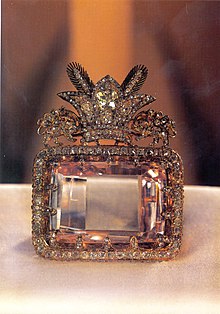OBSERVATIONS & TIPS
1. Money. Oct 2019 official bank rate was 1€ = 12,470 rials. You get tremendous wads of cash.The zeros get confusing as many people drop one to three zeros.
2. Driving. Pedestrians get no respect, crosswalks are meaningless. The drivers are a little crazy, besides the pedestrian issue, there are no roundabout rules, they cross lanes and drive fast. It seems that whoever is bigger or ahead had the right of way.
3. Virtually all signs are in Farsi script, similar to Arabic but with a few extra vowels, and just as unintelligible. This would make driving in the country difficult.
4. Women’s dress. Only the feet, hands, face and hair can be exposed. All wear at least a head scarf – rarely full chador, some with their hair completely covered and most with some hair exposed. The younger women tend to only have the back ⅓ of the hair covered. In the very religious cities of Kashan and Qom, full black chadors are worn by all women.
5. Food. The cuisine is based on barbecue (often kababs made of ground meat and chicken), chicken wings and drumsticks, grilled tomatoes, always rice and various stews of meat and vegetables. After 12 days of it, the food became a little tiring.
6. Being a Canadian in Iran. For a visa, we are one of the three countries in the world that require a tour. Theoretically, we need to be accompanied by a guide at all times – met at the airport, necessary to check into a hotel and whenever we are outside our hotel room. Practically speaking, I was not met at the airport and outside of Tehran, I was allowed to wander anywhere in the evening.
7. Blocked Websites. Facebook, Twitter, Google and surprising the site where I play bridge – Bridgebase.com – are all blocked. It is impossible to download Google Maps here so download any maps before you arrive. Despite Facebook being blocked, about 50% of Iranians are on it using a VPN.
Iran – Tehran October 12-13, 2019
Day 1: Arriving Tehran, visiting Tehran
I flew from Ankara Turkey on Azerbaijan Airlines via Baku, Azerbaijan to Tehran, arriving at Imam Khomeini (IKA) Airport at 12:45 am. Unfortunately, the flight arrived at a terminal about 10 minutes away, and no one spoke English, I didn’t know that I was supposed to take a shuttle and I languished there for a couple of hours in the middle of the night. Finally, a taxi driver called the travel agency’s emergency number and I got a ride to my hotel, arriving at 3 am. This was my first hotel in months.
Breakfast in the hotel before the tour met at 09:30.
The group was 7 – a couple from Rio de Janeiro Brazil, a couple from London and two women from Sophia, Bulgaria, all in their late 20s and 30s. Our guide is a 56-year-old man, and very pleasant. We had a van. The temperature high was 29°C but a very dry heat.
TEHRAN (pop 8.7 million, 15 million in metropolitan area)
Tehran is the capital of Iran and Tehran Province. It is the most populous city in Iran and Western Asia and has the second-largest metropolitan area in the Middle East. It is ranked 24th in the world by the population of its metropolitan area.
In the Classical era, part of the territory of present-day Tehran was occupied by Rhages, a prominent Median city. It was subject to destruction through the medieval Arab, Turkic, and Mongol invasions. Its modern-day inheritor remains as an urban area absorbed into the metropolitan area of Greater Tehran.
Tehran was first chosen as the capital of Iran by Agha Mohammad Khan of the Qajar dynasty in 1796, to remain within close reach of Iran’s territories in the Caucasus, before being separated from Iran as a result of the Russo-Iranian Wars, and to avoid the vying factions of the previously ruling Iranian dynasties. The capital has been moved several times throughout history, and Tehran is the 32nd national capital of Iran. Large-scale demolition and rebuilding began in the 1920s, and Tehran has been a destination for mass migrations from all over Iran since the 20th century.
Tehran is home to many historical collections, including the royal complexes of Golestan, Sa’dabad, and Niavaran, where the two last dynasties of the former Imperial State of Iran were seated. Tehran’s most famous landmarks include the Azadi Tower, a memorial built under the reign of Mohammad Reza Shah of the Pahlavi dynasty in 1971 to mark the 2,500th year of the foundation of the Imperial State of Iran, and the Milad Tower, the world’s sixth-tallest self-supporting tower which was completed in 2007. The Tabiat Bridge, a newly built landmark, was completed in 2014.
The majority of the population of Tehran are Persian-speaking people, and roughly 99% of the population understand and speak Persian, but there are large populations of other ethnolinguistic groups who live in Tehran and speak Persian as a second language.
Tehran has an international airport (Imam Khomeini Airport), a domestic airport (Mehrabad Airport), a central railway station, the rapid transit system of Tehran Metro, a bus rapid transit system, trolleybuses, and a large network of highways.
There have been plans to relocate Iran’s capital from Tehran to another area, due mainly to air pollution and the city’s exposure to earthquakes. A 2016 survey of 230 cities by consultant Mercer ranked Tehran 203rd for quality of life. According to the Global Destinations Cities Index in 2016, Tehran is among the top ten fastest growing destinations.
The temperature varies from -10 in the winter to highs of +48 in the summer. The elevation extends from 1000m up to 1800m at the base of the mountains. 2 ski resorts are very near.
Carpet Museum. More than 100 spectacular Persian hand-woven carpets and rugs from all over Iran. Learn the history of these carpets. There are two types, Nomad
Milad Tower. In the NM “Modern Architecture Buildings”, this communications tower is Tehran’s and Iran’s tallest structure at 435m tall to the tip of the antennae and the 6th tallest tower in the world (Tokyo, Canton, Moscow, CN Tower in Toronto). Take the elevator to the observation deck at 280m to see all the mountains to the north through the smog and Tehran, a monotony of white buildings below. Then go up to the dome at 302m (1,193 steps with a record ascent in 10’ 45”) to see several wax figures of famous Iranians including many poets. Then we went down to the coffee shop.
The complex also consists of a convention centre, hotel, dolphinarium and zip line.
We went to a lovely restaurant in a canyon at the base of the mountains for lunch. A small natural waterfall provided natural air conditioning. Our guide has planned lunches to give us a good introduction into Iranian cuisine. Today we had salad and chicken kabobs, in too large a portion.
Sa’ad Abad Complex. With an immense area of 1,100,000 square meters and 18 magnificent historical palaces, two of which we visited. The complex was first built and inhabited by Qajar monarchs in the 19th century. After an expansion of the compounds, Reza Shah of the Pahlavi Dynasty lived there from 1925-41, and his son, Mohammad Reza Pahlavi, used it as a summer residence from 1941-79 at the time of the Iran Revolution. After the 1979 Revolution, the complex became a museum. It is set in a huge park set high above the city. It receives 2m of snow in the winter and was not used then.
Green Palace. The home of Reza Shah, the outside is cladded with fantastic veined marble. Inside see fantastic rooms with intricate glass and mirror mosaics with the highlight being the Mirror Room and the bedroom.
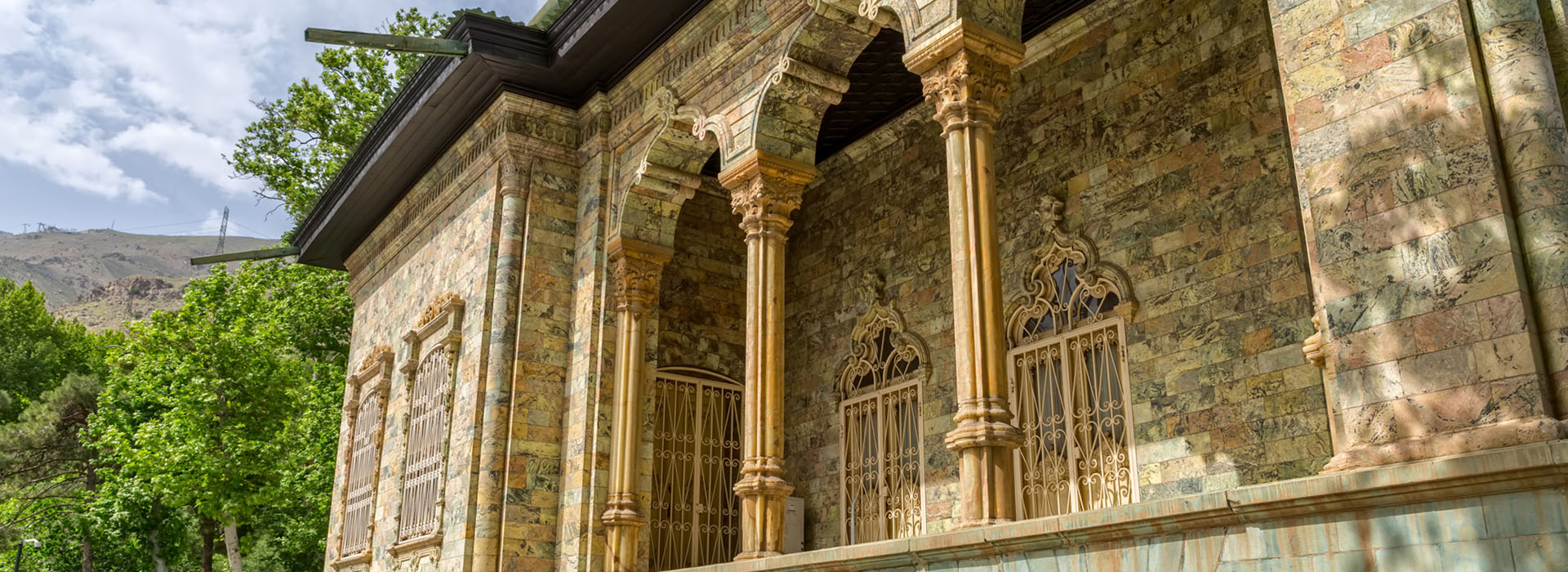
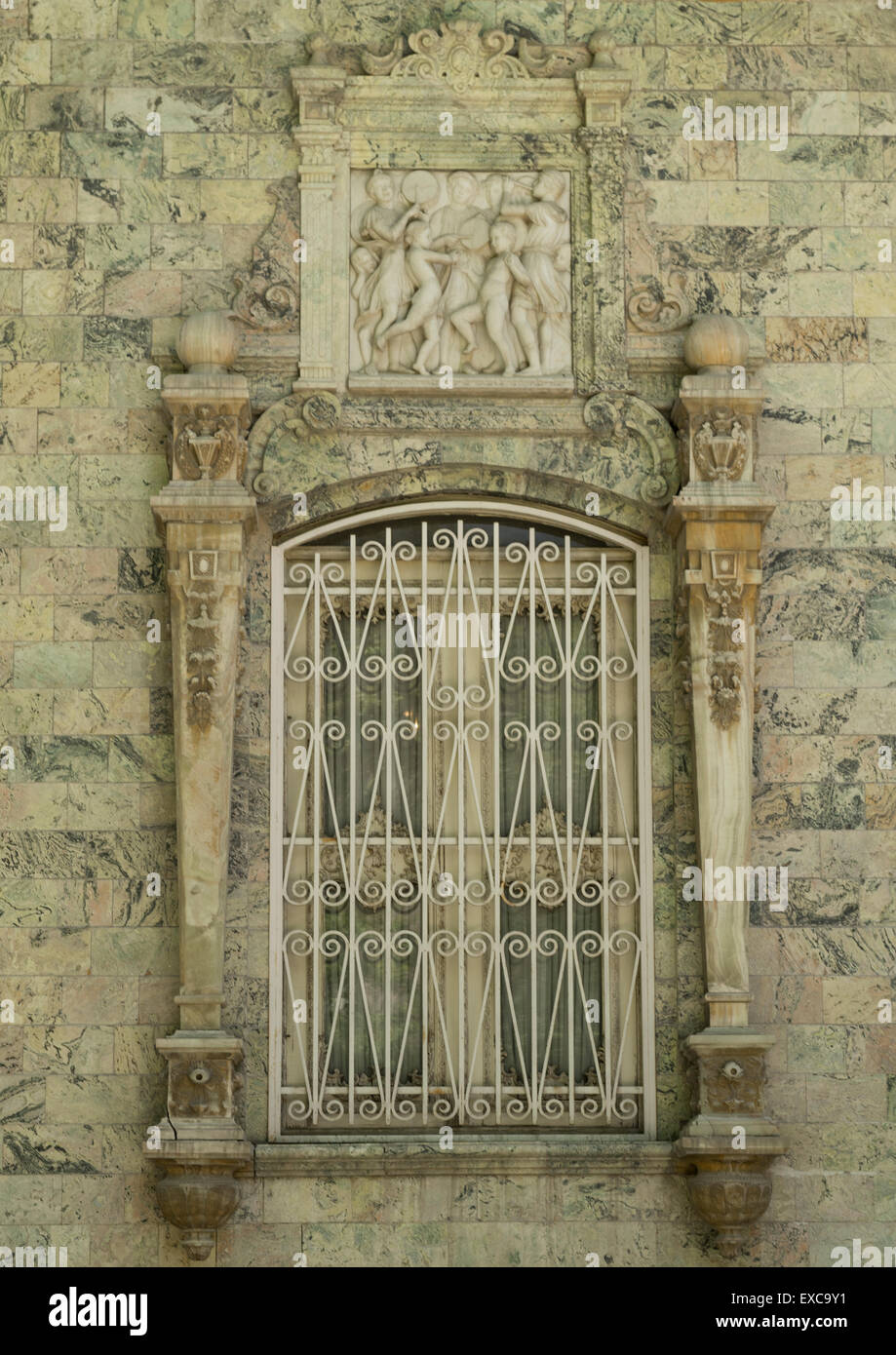
The green tone to the marble is very unusual.
White Palace. Reza Pahlavi’s palace, it had 11 meeting rooms clad in brocade wallpaper, stucco/gilt ceilings, crystal changeliers, a lovely wood games room, the grand dining hall set with 7 sets of different china and fantastic antique carpets.
Nature Bridge. The Tabi’at Bridge (literally meaning: Nature Bridge) is the largest pedestrian overpass in Tehran. The 270-metre (890 ft) bridge connects two public parks — Taleghani Park and Abo-Atash Park — by spanning Modarres Expressway, one of the main highways in northern Tehran.
The bridge has won several awards. Construction of the bridge started in 2010, using a total of 2000 tons of steel and 10000 cubic metres of concrete before it was finished in October 2014. Construction of the bridge over a large highway was described as a big challenge, with platforms and temporary tunnels built to ensure that nothing fell onto the road below.
The bridge not only connects two parks, it is a popular gathering place for the community in its seating areas and restaurants, acting as a place for people to stay not just pass.
We went here in the evening to walk the bridge. Then we had dinner at a high-end restaurant. I had the most expensive thing on the menu, lamb kebabs (popsicles), very good and cost about €11, so food relatively inexpensive.
Day 2
Reza Abbasi Museum located in Seyed Khandan. The museum was named after Reza Abbasi; one of the artists in the Safavid period. It is home to a unique collection of Persian art dating back to the second millennium BC, from both the pre-Islamic and Islamic eras. Amazing gold, pottery, metal work (oil lamps, censors), miniatures, calligraphy.
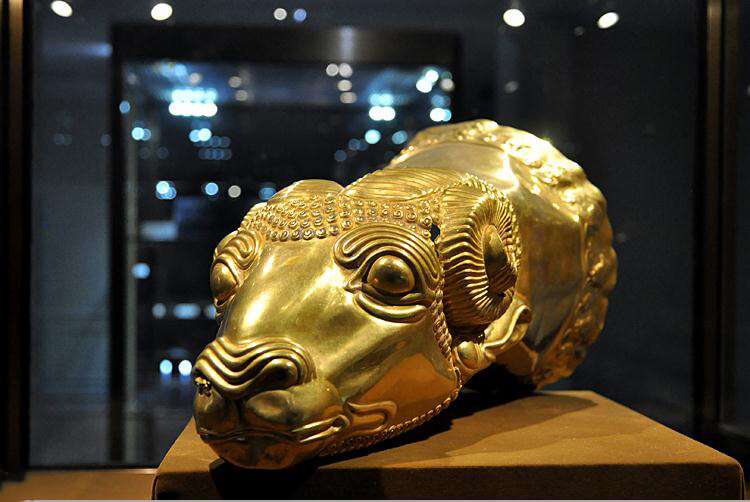
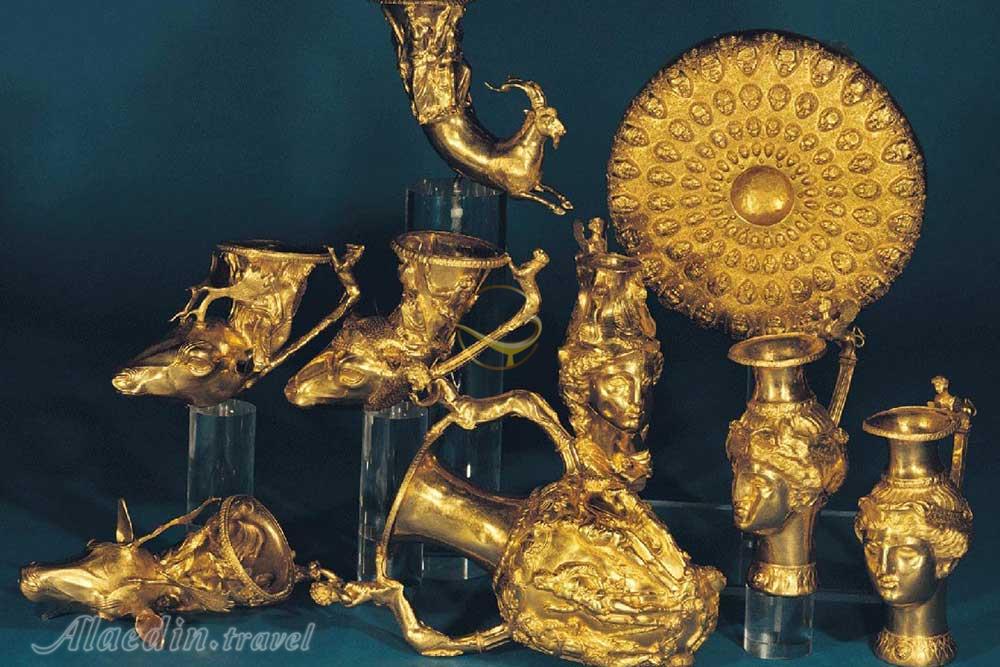
GOLESTAN PALACE World Heritage Site
The Golestan Palace is the former royal Qajar complex in Tehran. One of the oldest historic monuments in the city, it was once enclosed within the mud-thatched walls of Tehran’s arg (“citadel”). It consists of gardens, royal buildings, and collections of Iranian crafts and European presents from the 18th and 19th centuries.
Tehran’s arg (“citadel”) was built during the reign of Tahmasp I (r. 1524–1576) of the Safavid dynasty (1502–1736), and was later renovated by Karim Khan of the Zand dynasty (r. 1750-1779). Agha Mohammad Khan of the Qajar dynasty (1742–1797) chose Tehran as his capital. The court and palace became the official residence of the Qajar dynasty (1794–1925). The palace was rebuilt to its current form in 1865 by Haji Ab ol Hasan Mimar Navai.
During the Pahlavi era (1925–1979), the Golestan Palace was used for formal royal receptions, and the Pahlavi dynasty built their own palace (the Niavaran Complex) in Niavaran. The most important ceremonies held in the palace during the Pahlavi era were the coronation of Reza Shah (r. 1925-1941) on the Marble Throne and the coronation of Mohammad Reza Pahlavi (r. 1941-deposed 1979) in the Museum Hall.
In between 1925 and 1945, many of the buildings of the complex were destroyed on the orders of Reza Shah. He believed that the centuries-old Qajar palace should not hinder the growth of a modern city. In the place of the old buildings, commercial buildings with the modern style of 1950s and 1960s were erected.
SITES in the Golestan Palace
The complex of Golestan Palace consists of 17 structures – palaces, museums, and halls, most built during the 131 years rule of the Qajar kings.
Marble Throne. This spectacular terrace, built in 1806 by Fath Ali Shah of the Qajar dynasty (r. 1797–1834), embodies the finest of Iranian architecture and is one of the oldest buildings of the historic arg. The façade is yellow brick separating great tiled scenes. The inside has paintings, marble-carvings, tile-work, stucco, mirrors, enamel, woodcarvings, and lattice windows. The throne is situated in the middle of the terrace (iwan), and is made of 65 pieces of famous yellow translucent marble from Yazd Province. Several celebrated masters of the time worked on the execution of this masterpiece. The architectural details and ornaments of the terrace were completed between1848–1896.
The hall is open to the air with the opening covered by a giant piece of white patterned cloth than hangs on the outside of the façade. The room is completely mosaic mirrors (some in intricate stalactites) with intricate inlaid wood doors, a bas-relief floral covered marble lower wall and the throne sitting in the middle. The throne is supported by several female statues and a demon figure on one end. A room off to the side has stucco carvings on all the walls and a series of large paintings of the Qajar kings.
Coronations of the Qajar kings and formal court ceremonies were held on this terrace. The last coronation held here was the coronation of Reza Shah of the Pahlavi dynasty, in 1925.
Karim Khani Nook. Originally part of the residence of Karim Khan of the Zand dynasty, it dates to 1759. It is a small simple terrace with arcades, tiled domes, a small marble throne and a pond with a fountain in the middle supplied with water from the king’s subterranean qanat.

Nasser ed Din Shah of the Qajar dynasty was fond of this corner of the Golestan Palace and spent much time here in rest and repose, smoking his water-pipe in quiet reflection. His spectacular marble sarcophagus with his image engraved on the top is in the nook.
Pond House. Used as a summer chamber by the Qajars, it has work by European painters presented to the Qajar court. A special cooling system pumped water from a qanat through as many summer rooms as was necessary but because of the harmful effects of humidity, this system is no longer in use.
Brilliant Hall. The Brilliant Hall was named for the brilliant mirror work of Iranian artisans and its chandeliers.

Containers Hall. This building exhibits in show cases, the exceptional chinaware given to Qajar kings by European kings: the Napoleonic Wars given by Napoleon Bonaparte, Nicholas I of Russia, chinaware studded with gems and jewels given by Queen Victoria, Wilhelm II and the highlight for me, a set made of malachite given by Alexander III of Russia
Ivory Hall. This large hall was used as a dining room and is decorated with gifts presented to Nasser ed Din Shah by European monarchs.
Mirror Hall. The Mirror Hall is the most famous of the halls of the Golestan Palace. This relatively small hall is famous for its extraordinary mirror work.

Salam Hall (“Reception Hall). It originally held the Sun Throne that is now in the Royal Jewels Museum at the Central Bank of Iran and has exquisite mirror works. The ceiling and walls are decorated with plaster molding, and the floors are covered with mosaic.
Diamond Hall. It also has exceptional mirror work. The walls are covered with wallpaper imported from Europe and exhibits art and handicrafts from that period.
Building of Windcatchers. Flanked by two corner rooms enclosing a central room with the finest stained glass window in the Golestan Palace. Outside are four wind towers of blue, yellow and black glazed tiles and a golden cupola. The Windcatchers are constructed to allow the cooling wind move through the structure.
Edifice of the Sun. Considered the most stunning structure of the entire palace complex, it was built to have panoramic views of the city, it has two identical towers. The exterior views have multiple arches, intricate tile work and ornate windows.
Museum of Gifts. Located under the Salam Hall, the Pahlavi dynasty, used it to show the rare gifts given to the Qajar kings plus the helmet of king Ismail I, bow and arrows of King Nader, armband of Fath Ali Shah, the collection of Qajar Seals, Agha Mohammad Khan’s crown and decorated ostrich egg
Abyaz Palace. The Ottoman Sultan Abdul Hamid sent many precious gifts to Nasser ed Din Shah and this exhibit hall was built to show them. Completed in 1883, the”White” Palace now has ethological museums that includes a colourful exhibition of traditional Iranian costumes and folk art.
Museum Hall. Nasser ed Din Shah was very impressed by the exhibition of artifacts and valuable objects at European museums during his second European tour around 1872. He arrived back in Tehran intent on building a museum hall to exhibit paintings, royal jewels, and other royal artifacts.
The original collection is now scattered among Tehran’s many museums, but the paintings of the royal court are here – the European paintings at the Pond House and Iranian painters showing the evolution of painting in Iran during the Qajar era.
Present use. Golestan Palace is the result of roughly 400 years constructions and renovations. It was World Heritage Site listed in 2013.
National Museum of Iran. This institution has two complexes; the Museum of Ancient Iran which was opened in 1937, and the Museum of the Islamic Era which was opened in 1972. It hosts historical monuments dating back through preserved ancient and medieval Iranian antiquities, including pottery vessels, metal objects, textile remains, and some rare books and coins.
 Basically an archaeology museum with treasures from many parts of the country, most of the highlight objects came from Persepolis with its black granite carved intricately and highly polished. The 1700 year old “Salt Man” was an incredibly well preserved (because of the salt mine) 35ish year old man. All hair was present along with several artifacts present on his body (tools, a bag).
Basically an archaeology museum with treasures from many parts of the country, most of the highlight objects came from Persepolis with its black granite carved intricately and highly polished. The 1700 year old “Salt Man” was an incredibly well preserved (because of the salt mine) 35ish year old man. All hair was present along with several artifacts present on his body (tools, a bag).
For lunch we went to restaurant packed with tour groups. We had one of the famous kababs of Iran made of spiced minced lamb. Every meal is served with rice and baked tomato.
National Jewelry Museum. In the Central Bank of the Islamic Republic of Iran, the incomparable “Treasury of the National Jewels” is a collection of the most expensive jewels of the world, collected over centuries. Every piece of this collection is a reflection of the tumultuous history of Iran. Before you are overwhelmed by its glitter, consider the historic reasons for collection of these jewels. They are on one hand a reflection of the creativity and taste of Iranian craftsmen and artists, but also repeats the silent tears of oppressed people who worked hard and instead the rulers, showed the glory and extravagance of their courts, their arrogance and power with their gold and jewels.
See a world of totally over-the-top jewel encrusted treasures including elaborate crowns, thirty tiaras, and numerous aigrettes, a dozen bejeweled swords and shields, a number of unset precious gems, numerous plates and other dining services cast in precious metals and encrusted with gems, and several other more unusual items (such as a large golden globe with the oceans made of emeralds) collected or worn by the Persian monarchs from the 16th century (Safavid Persia) on.



Daria-i-Noor diamond (“Sea of light”), it is one of the largest cut diamonds in the world, weighing an estimated 182 carats (36 g) and is 41.40 x 29.50 x 12.15 mm in size. It is straight cut with no facets, making it translucent. Its colour, pale pink, is one of the rarest to be found in diamonds. Like the Koh-i-Noor, it was mined in Vijayanagara, India. In 1739, Nader Shah of Iran invaded Northern India. As payment for returning the crown of India to the Mughal emperor, he took possession of the entire fabled treasury of the Mughals, including the Daria-i-noor, in addition to the Koh-i-noor and the Peacock throne. In 1747 AD, the treasury of Nadir was looted and one of the famous jewels that left Iran and never returned was the famous “Kooh-e-Nur” (Mountain of Light) diamond. After the defeat of Ranjit Singh of Punjab by the British government, the Kooh-e-Nur diamond fell into the hands of the East India Company, and in 1850, it was given to Queen Victoria as a gift.
During the Qajar period, the Treasury was collected and recorded. Some of the stones were mounted on the Kiani Crown, the Nadir Throne, the Globe of jewels, and the Peacock Throne (or the Sun Throne).
There are crowns, knives, covers for food and everything imaginable covered with gems.
Grand Bazaar. This large bazaar was not so interesting, mostly clothes and housewears. I was looking for several things (a hat, umbrella, day pack with no padding) but none was here (Iranian men don’t wear hats).
Bazaars in Iran are the economic life of the country. Moreover, social relations are formed here.
Shah-e Cheragh. This is one of the most beautiful shrines in Iran with its beautiful dome, wonderful lighting and Mirror-work.
After the bazaar, we drove to Mehrabad (THR) the municipal airport to catch the 1⅔ hour flight to Shiraz.
On October 21st, we returned to North Central Iran and Tehran from Kashan and Isfahan, and visited Qom.
QOM (pop 1,201,000)
Qom is the seventh metropolis and also the seventh largest city in Iran. It is located 140 km (87 mi) south of Tehran. It is situated on a low plain on the banks of the Qom River.
Qom is considered holy by Shiʿa Islam, as it is the site of the shrine of Fatimah bint Musa, sister of Imam Ali ibn Musa Rida (Persian Imam Reza, 789–816 CE). The city is the largest center for Shiʿa scholarship in the world, and is a significant destination of pilgrimage, with around twenty million pilgrims visiting the city every year, the majority being Iranians but also other Shi’a Muslims from all around the world.
Qom is famous for a Persian brittle toffee known as Sohan, considered a souvenir of the city and sold by 2,000 to 2,500 “Sohan” shops.
Qom has developed into a lively industrial centre owing in part to its proximity to Tehran. It is a regional centre for the distribution of petroleum and petroleum products, and a natural gas pipeline from Bandar Anzali and Tehran and a crude oil pipeline from Tehran run through Qom to the Abadan refinery on the Persian Gulf. Qom gained additional prosperity when oil was discovered at Sarajeh near the city in 1956 and a large refinery was built between Qom and Tehran.
Geography. The city is located in the boundary of the central desert of Iran (Kavir-e Markazi). Qom is a focal center of the Shiʿah. Since the revolution, the clerical population has risen from around 25,000 to more than 45,000 and the non-clerical population has more than tripled to about 700,000. Substantial sums of money in the form of alms and Islamic taxes flow into Qom to the ten Marja’-e taqlid or “Source to be Followed” that reside there. The number of seminary schools in Qom is now over fifty, and the number of research institutes and libraries somewhere near two hundred and fifty.
Its theological center and the Fatima Masumeh Shrine are prominent features of Qom. Jamkaran is another very popular religious site of pilgrimage. Qom’s proximity to Tehran has allowed the clerical establishment easy access to monitor the affairs and decisions of state. Many Grand Ayatollahs possess offices in both Tehran and Qom; many people simply commute between the two cities as they are only 156kms apart. Southeast of Qom is the ancient city of Kashan. Directly south of Qom lie the towns of Delijan, Mahallat, Naraq, Pardisan City, Kahak, and Jasb.
Climate. Qom has a hot desert climate with low annual rainfall due to remoteness from the sea and being situated in the vicinity of the subtropical anticyclone aloft. Summer weather is very hot and essentially rainless, whilst in winter weather can vary from warm to – when Siberian air masses are driven south across the Elburz Mountains – frigid, in January 2008 when minima fell to −23 °C or −9.4 °F.
History. The present town of Qom in Central Iran dates back to ancient times. Large inhabited places south of Qom date from the 4th and 1st millennium BC. While nothing is known about the area from Elamite, Medes, and Achaemenid times, there are significant archeological remains from the Seleucid and Parthian epochs, of which the ruins of Khurha (about 70kms southwest of Qom) are the most important. Khor Abad at Qomi from the 9th century had four Parthian heads now in the National Museum of Iran in Tehran.
The Arab conquest of Qom occurred in 644. The first permanent settlement of Arab settlers in Qom occurred in 685–96, when small groups of refugees moved there. The group of Ashaari Arabs from Yemen had large herds of cattle, required a great deal of pasture and were much wealthier than the local Persians. They slowly started to buy land, take over more villages and eliminated the local Persian noble class after the death of Yazdanfadar in 733. This led to the fusion of the original six villages on the area of Qom to an urban conglomerate.
The Mongol invasion in 1223 led to the total destruction of Qom and the city lay in ruins for at least twenty years. In the late 14th century, the city was plundered by Tamerlane and the inhabitants massacred. By 1503, Qom became one of the important centers of Shia Islam as a religious pilgrimage site. Finally in 1793 Qom came under the Qajars ushering in an era of prosperity. After Russian forces entered Karaj in 1915, many of the inhabitants of Tehran moved to Qom. In 1964–65, before his exile from Iran, the Ayatollah Khomeini led his opposition to the Pahlavi dynasty from Qom.
Education. Qom is well known for its many religious seminaries and institutes that offer advanced religious studies, which made this city the largest center for Shia scholarship in the world. There are an estimated 50,000 seminarians in the city coming from 80 countries, including 6,000 from Pakistan alone. Qom has seminaries for women and some non-Shia students. Most of the seminaries teach their students modern social sciences and Western thought as well as traditional religious studies.
The death of Fātimah bint Mūsā, the sister of the eighth Imam of Shias Ali al-Ridha in the city in 201/816–17 proved to be of great importance for the later history of Qom. The place of her entombment developed from 869–70 into a building that was transformed over time into today’s magnificent and economically important sanctuary.
From the middle of the 9th century, Qom became increasingly important as a center of Shia learning. The first Friday mosque in Qom was built in 878–79 on the site of a fire temple. From 988-89, Qom was isolated inside Persia because of its Shia creed and the Fatima sanctuary was enlarged. The population of 50,000 consisted of Persians and Arabs who had adopted the Persian as their language. Mines of silver, iron, gold and lead, salt from a lake nearby and chairs, textiles, and saddle equipment.
Fatemeh Masoumeh Shrine. The death of Fātimah bint Mūsā, the sister of the eighth Imam of Shias Ali al-Ridha in the city in 201/816–17 proved to be of great importance for the later history of Qom. Fātimah bint Mūsā died while following her brother to Khorasan, a region in northern Iran. The place of her entombment developed from 869–70 into a building that was transformed over time into today’s magnificent and economically important sanctuary.
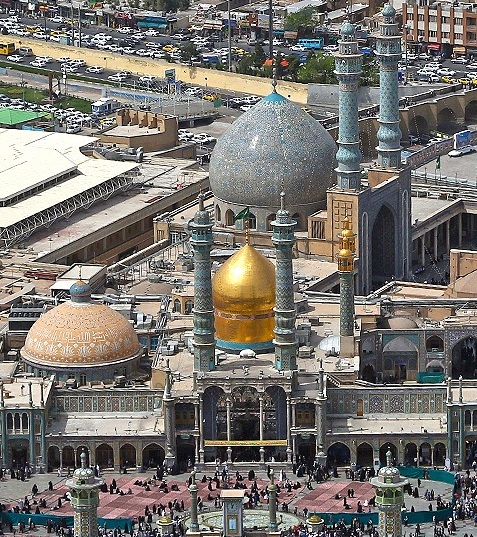
The oldest parts are some 500-year-old foundations. The complex has been constantly renovated and enlarged and all looks new – a spectacle of coloured tiles, minarets, small towers on the gates and magnificent domes. Seeing the shrine requires a guide from the complex and no buildings can be entered by non-Muslims.
Enter onto a 6-year-old large courtyard centered on a mosque with a gigantic dome, two minarets and a nice portal. On the far side is the entry to the courtyard of the shrine. Its dome has 119kgs of gold, portal, 33kgs on the maqarnas portal and 19kgs on the small roofed “Shah’s balcony” on the opposite side of the shrine. Behind the large gold dome is another large dome of the mosque inside the shrine. From the outside, one can get a look at the tomb – silver grated under a gold roof.
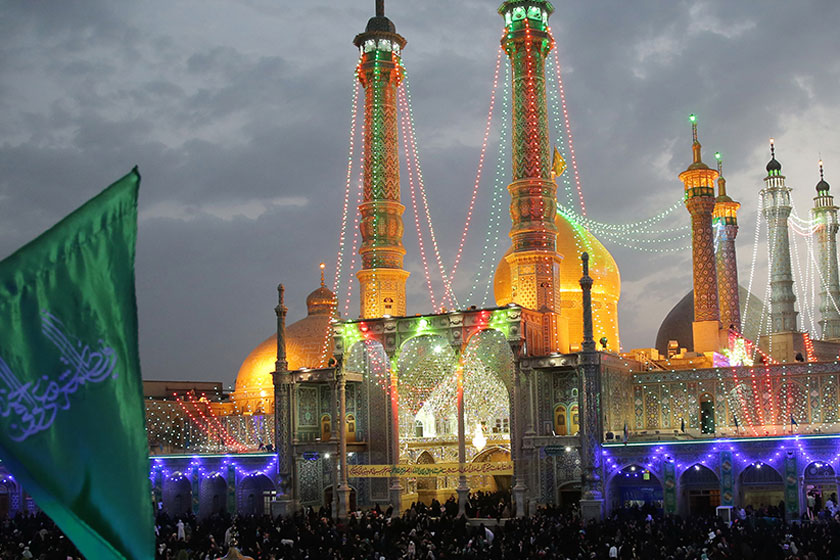


Eshan Pond Textile Factory. In the NM “Modern Architecture Buildings” series, this angular factory complex created on the industrial outskirts of the ancient city, the building draws from the forms and shapes of the textile industry, appearing like a massive, futuristic sewing machine.
